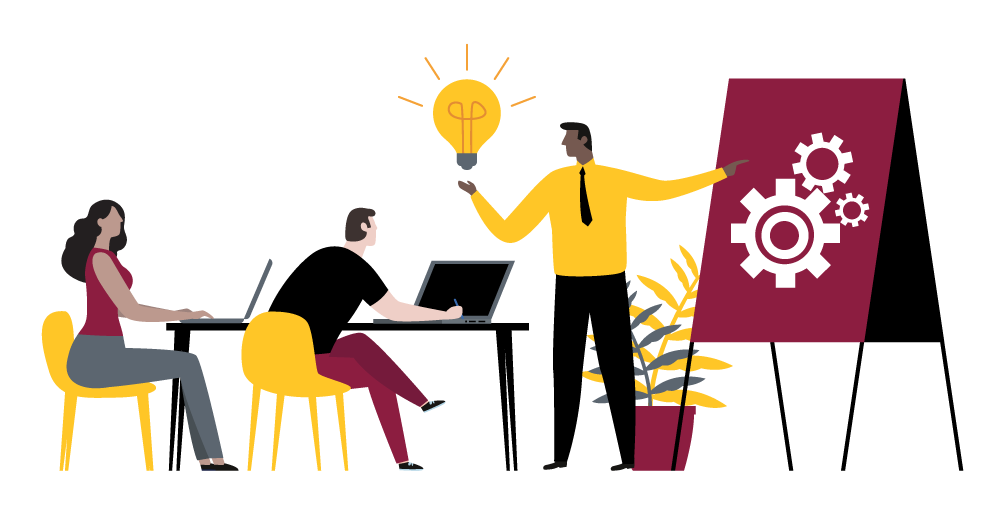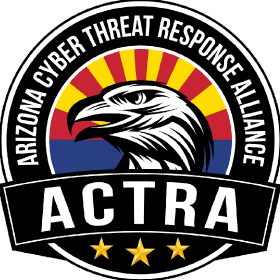Thank you for your interest in AZNext.Due to the conclusion of current funding, no AZNext training courses are scheduled for 2026 at this time. If new funding becomes available, we hope to offer additional courses in the future. In the meantime, many similar learning opportunities are available through other ASU programs, including:
• Executive Education and Lifelong Learning
• ASU Universal Learner Courses
Please note that these programs are not part of AZNext and may require enrollment fees. We remain committed to providing workforce training at no cost when funding allows and appreciate your interest and understanding.
AZNext: Workforce Training Accelerator Partnership for Next Generation Jobs
The Arizona State University AZNext Program is a public-private partnership designed to create a bold, innovative, and sustaining workforce development ecosystem that addresses the need for more skilled workers in IT, cybersecurity, and advanced manufacturing roles. Through bridging collaboration between the W. P. Carey School of Business, Ira A. Fulton Schools of Engineering, and New College of Interdisciplinary Arts and Sciences with employers, workforce development networks, economic development organizations, and industry partnerships, AZNext creates job-training, upskilling, and reskilling models designed to connect technically skilled and certified workforce to next generation jobs.
Spotlight
New AWS program
Gain in-demand Amazon Web Services (AWS) skills with our new, no-cost AWS Cloud Computing Foundations training.
The curriculum covers cloud platforms, containers, data platforms, data integration, and data visualization. Learners will emerge with a digital certificate and the opportunity to apply for a paid apprenticeship, internship, or full-time position with one of our industry partners.
Testimonials
Check out this interview with Tekletic’s Casey Fox as he discusses AZNext’s ability to build boot camps specific to employer needs or veterans discuss what they got out of the Business Readiness for Vets program that they immediately applied to their careers on our AZNext YouTube Channel.
You can also follow us on Instagram and subscribe to our newsletter at AZNext_ASU.
Partnerships
Some recent notable industry partnerships with AZNext include upskilling and reskilling members of The National Center for Women & Information Technology (NCWIT) in Fintech and other programs, Bakers Equipment Manufactured and Allieds (BEMA) on the Internet of Things.
Also working with Cloud Range on Cybersecurity Programming and Connecting with Trailhead and Salesforce for a Developer Academy.
ASU leads effort to upskill, reskill workforce through $8M grant
The U.S. Department of Labor has awarded Arizona State University an $8 million grant to lead an innovative workforce development partnership to help train workers for high-paying, high-demand jobs in advanced manufacturing, cybersecurity and information technology (IT).
Arizona PBS Horizon: Rob Buelow discusses AZNext
AZNext specifically focuses on programs leading to high-skilled, high-wage jobs in the field, including cybersecurity and artificial intelligence.
Upskill or reskill to move your career forward through a grant awarded to ASU by the U.S. Department of Labor
As artificial intelligence, automation enabled technologies, data analytics and engineering advancement change employer needs and opportunities, our workforce development program will help you gain the skills necessary to fill the open positions that come with them. AZNext is designed to build your skills, and provide access next generation opportunities. Partner employers are equally committed to this mission, offering professional experiences and training toward career paths focused on IT, Cybersecurity and Advanced Manufacturing.
Contact us or read our FAQ for updates and more information.
Advanced Manufacturing
- Computer-aided Design Technician
- Electrical Engineers
- Energy Engineers
- Engineering Technologists
- Industrial Engineers
- Manufacturing Engineers
- Mechanical Engineers
- Robotics Engineers
IT and Cybersecurity
- AI Prompt Master
- Business analysts
- Computer and information analysts
- Computer programmers
- Computer support specialists
- Computer systems analysts
- Computer user support specialists
- Cloud Engineer
- Database administrators
- Data Scientist
- Dev Ops Engineer
- Information security analysts
- Management analysts
- Machine Learning Engineer
- Network Engineer
- Network Systems Administrator
- Security Analyst
- Software Engineer
- Software/Bot developers and programmers
- Software Q/A Engineer/Tester
- Web developers
Types of Training Models
Simulated work experience
Provides the experience of traditional work-based learning in a non-workplace setting.
Employer Upskilling and Retention
Workforce training design and infrastructure for upskilling your employees.
Internship
A paid experience integrating knowledge and theory learned in the classroom with practical application in a professional skill.
Train-to-hire program
A training program in line with employer hiring needs leading to interviews and placement upon successful completion.
Pre-apprenticeship
A short-term training in technical and soft skills to prepare for an apprenticeship program.
Apprenticeships
A competency-based program combining paid on-the-job training (OJT) and related instruction leading to an industry credential.
Note: A registered apprenticeship requires 2000 hours OJT and has additional DOL benefits for employer. An unregistered apprenticeship has flexible program length.
AZNext Team
Grant Staff
- Raghu Santanam, Executive Director
- Rob Buelow, Program Director
- John DeLalla, Business Development Director
- Mike Benesh, Program Coordinator
- Veronica Gavotto, Program Manager, Workforce Development
- Jeania Kimbrough, Project Manager Research
- Anna Choi, Project Manager Research, CAPS Research
- Savita Rao, Program Coordinator
- Kim Danielson, Program Facilitator
Academic Program Leaders
- Arunachala Mada Kannan, Fulton Schools of Engineering
- Edgard Luque, W. P. Carey School of Business
- Thomas Sugar, Fulton Schools of Engineering
- Karen Watanabe-Sailor, The New College

Partners
Community




- AZCEND
- Black Chamber of Arizona
- Center for the Future of Arizona
- City of Phoenix
- Greater Phoenix Economic Council
- Institute for Supply Management
- Maricopa Community Colleges
- Maricopa County
- Partnership for Economic Innovation
- Pipeline AZ
- Scitech Institute
- Tucson Metro Chamber
Employer
Information Systems / Cybersecurity




- American Express
- AutoMon
- Caterpillar
- Choice Hotels
- Cinteot
- Cognizant
- CommonSpirit
- Deloitte
- Celltrust
- Entrepix
- Fortinet
- HCL Software
- IDlink
- Infosys
- InStride
- Intel
- Intuit
- Iron Mountain
- JNR Networks
- Knight Transportation
- Medtronic
- Nationwide
- Offerpad
- Oppty
- Paradox
- Petsmart
- Salesforce
- Siemens
- Silicon Valley Bank
- Sonoran Quest Laboratories
- SRP
- StandardAero
- Swift
- Tata Consultancy Services
- TEK Systems
- Tekletics
- Translational Genomics Research Institute
- TPI Composites
- Vertech
- Western Alliance Bancorporation
Advanced Manufacturing




- Boeing
- Chemonics
- Delta technology
- Eclipse Automation
- EVG
- Honeywell
- L3Harris
- Lallemand
- Lucid
- Marcu Engineering
- Nikola
- NXP Semiconductors
- Oryx Additive
- PADT
- Paradigm Manufacturing
- Pilgrim Aerospace Fasteners
- Raytheon
Register for our partner, Pipeline AZ!
Pipeline AZ is your resource for Arizona jobs, additional education, and career support services.
Registering for an account on Pipeline AZ connects you with jobs that are matched to you based on your education and experience. Upon registration, you will be able to see jobs that match to your AZNext Program of Study and Certification by adding your newly acquired certification and skillset to your profile for employers to see. If you already have an account on Pipeline AZ, you can also use this link to navigate to your account.
Get startedContact AZNext
AZNext is closing the skills gap to build the future workforce. Please email us at [email protected] to learn more about the ASU AZNext program.
This workforce product was funded by a grant awarded by the U.S. Department of Labor’s Employment and Training Administration. The product was created by the recipient and does not necessarily reflect the official position of the U.S. Department of Labor. The Department of Labor makes no guarantees, warranties, or assurances of any kind, express or implied, with respect to such information, including any information on linked sites and including, but not limited to, accuracy of the information or its completeness, timeliness, usefulness, adequacy, continued availability, or ownership. This product is copyrighted by the institution that created it.
ASU-AZNext is an equal opportunity employer/program. Auxiliary aids and services are available upon request to individuals with disabilities. asu.edu/about/title-ix